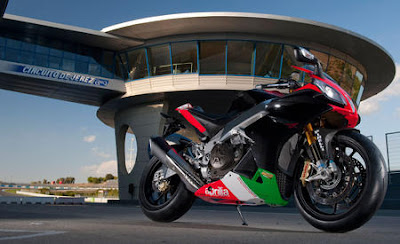The term high tech has never had a more suitable subject to describe outside of NASA than the Aprilia RSV4 Factory APRC SE. Traction control, launch control, wheelie control, triple ride-by-wire riding modes, quick shifter, and its even got blinkers incorporated into its mirrors! The RSV4 Factory APRC is what legends are made of.
Aprilia, by offering the APRC technology to a mainstream audience, has the recipe to shatter everything that stands in its way in 2011. You’ve got to love Aprilia’s attitude of daring to fail to succeed.
It takes guts to bring along a bike such as the RS3 Cube MotoGP bike using ride-by-wire as the first manufacturer to do so in MotoGP. It failed; Aprilia packed up its GP ambitions, rebooted its computers and came back stronger than ever in World Superbike with the RSV4 Factory and Max Biaggi.Aprilia developed a three-cylinder Cube from scratch then binned it. Then it went about building a new V-Twin, binned it, and finally chose a V-4. It built the V-4 from scratch in-house and launched it as quickly as it could with complications, but at the same time with race wins. Finally in 2010 Aprilia won the world superbike championship with BiaggiHaving followed this bike from the pre-concept stage to reality, I’m delighted to be able to give unconditional praise.
The RSV4 Factory APRC can be called a motorcycling virtuoso in the technical area. A combined (but competitive) effort from Aprilia,BMW and Ducati has bloodied the Japanese noses seriously in the last couple of years. Aprilia and Ducati have done it on the World Superbike circuits and BMW on the sales charts.
Now, let me tell you how good this bike is. On my very first lap the Aprilia technicians force-fed us level eight on the traction control. I thought; “how dull they are ruining my fun like this!” However they were right and I was wrong as this was the perfect way for me to ride the tightest Jerez corners using first gear, full throttle and just let the traction control automate me through the corners.
Without traction control such behaviour on your warm-up lap would end in tears guaranteed. After that I simply used the Mana (absolutely no reference whatsoever to anything else on that bike I promise) switch gear using the minus button to reach lower levels on the traction control or the plus button to go back up. A rider’s left index finger toggles the minus button, and a left thumb for the plus button which is intuitive, all while on the moveThere’s no sound or chugging or anything when the traction control kicks in. I could feel when the rear tire slipped but trusted the ATC instantly. The amount of rear wheelspin allowed is pre-determined depending on which TC level you choose. I worked my way all the way down to level one but I did a whole session using level four which suited me just fine.
Each of us had five sessions on the bike of which the first was to test traction control alone, second session to test wheelie control with traction control, third session to test launch control and the two last sessions to freely explore. That’s nearly two full hours of hardcore undiluted adrenaline pumping action.
Aprilia’s wheelie control is highly sophisticated and not only stops wheelies from happening between low-gear corners but it knows how much it should allow and how to land them soft to avoid upsetting the handling. Don’t you tell me that’s not very clever! The physicality of trying to curb a wheelie while racing is immense. Riders have to use their upper bodies like athletes forcing weight forward while accelerating and withstanding G-forces and wind resistance. Aprilia have with the AWC taken that physicality away, allowing the rider to concentrate on pinning the throttle.
The AWC has three levels to choose from, where I suspect level one is the only race one. Some front wheel lift is always allowed because as long as the wheelie isn’t too high you can still be at maximum acceleration levels. What’s really good about this from a racer’s perspective is to keep that front down between really quick directional changes in low gears while keeping the throttle wide open. A small wheelie is then accepted while you pin it and turn the bike over from side to side, landing it just in time to steer out of the next corner. And landing it smoothly to avoid upsetting the front more than the steering damper can handle. There’s gyrometer wizardry involved here, and not only sensors between the two wheelsHow does it work? Two gyrometers and two accelerometers are at the ECU’s disposal for any data it may need for the various systems. Anything a motorcycle can do whether it is vertically or horizontally the ECU is aware. So when we stupid people do something wrong with the throttle in the wrong place the system saves us from ourselves. Through the ride-by-wire system the ECU also knows the throttle position and based on pre-calculated algorithms based on a variety of conditions (you choose the levels, computer performs to that level).









No comments:
Post a Comment